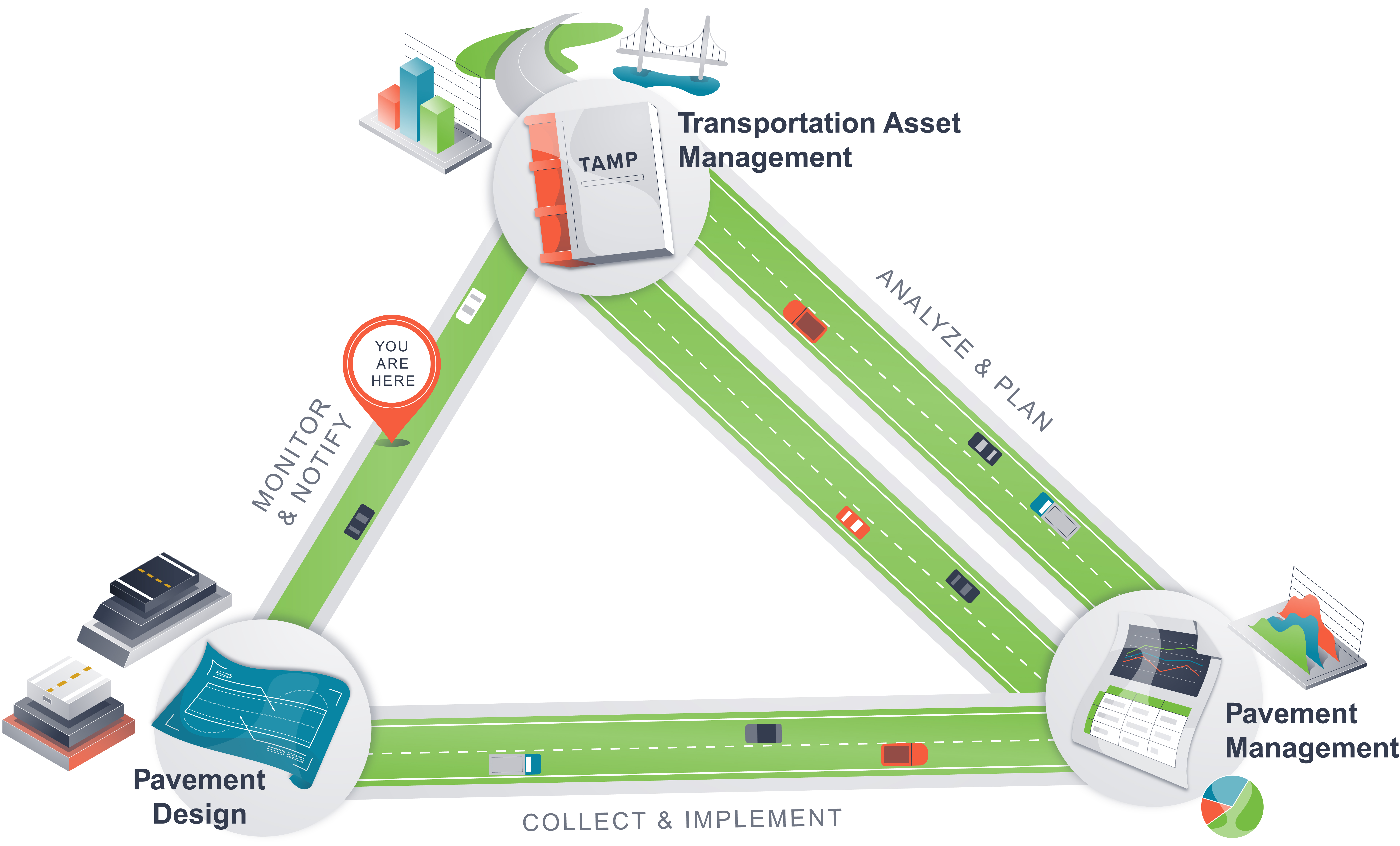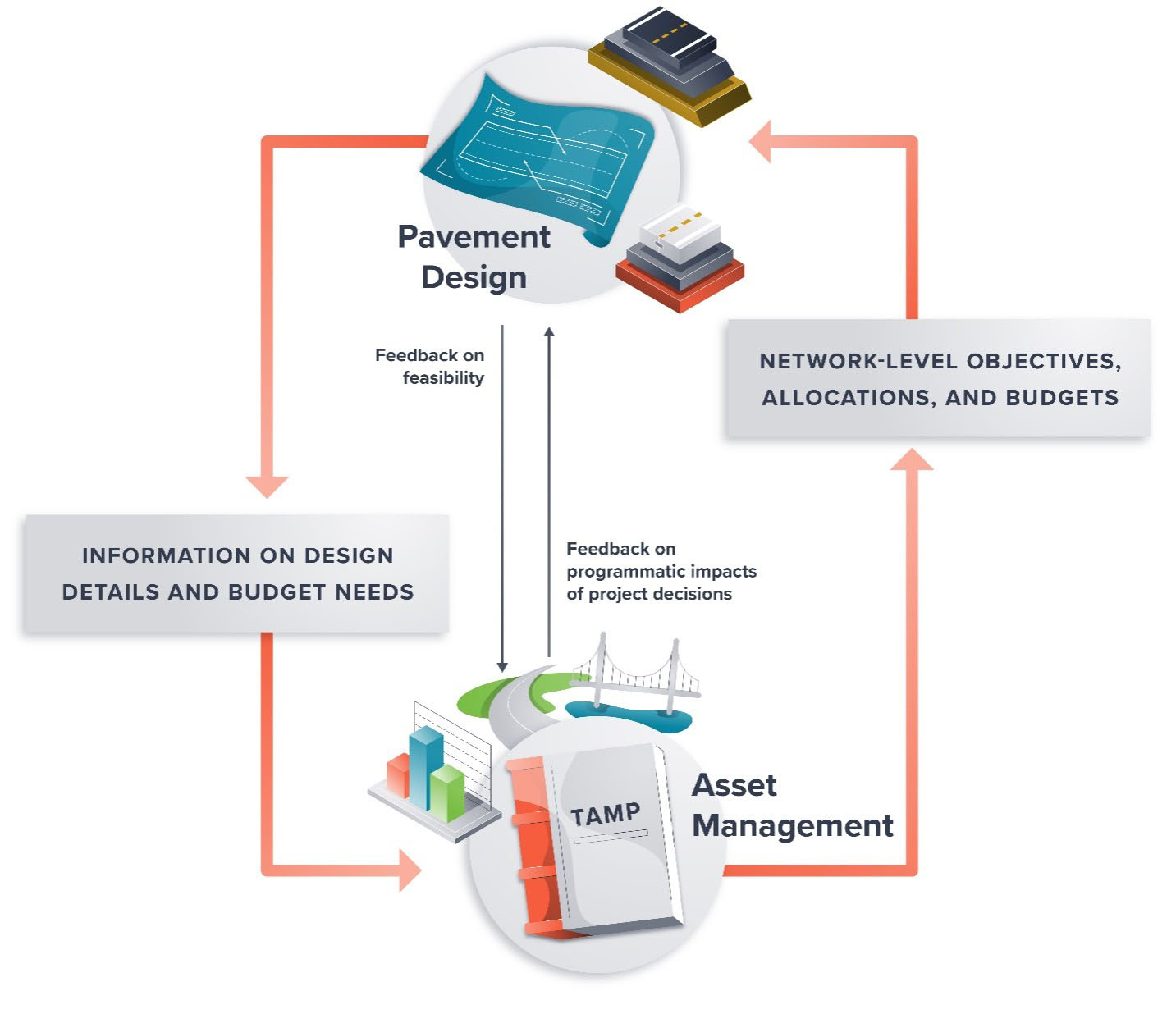Linking Pavement Design to Transportation Asset Management

Pavement design, pavement management, and TAM are linked because each function relies on information provided by the other two. This webpage provides information on the links between pavement design and asset management design, including why they are important; what data, systems, and organizational units support them; and how they can be strengthened. TAM is a strategic and systematic process of operating, maintaining, and improving physical assets – with a focus on both engineering and economic analysis based upon quality information – to identify a structured sequence of maintenance, preservation, repair, rehabilitation, and replacement actions to achieve and sustain a desired state of good repair (DSOGR) over the life cycle of assets at minimum practicable cost (23 CFR 515.5). Pavement design is a project-level effort based on detailed engineering and economic considerations meant to optimize pavement type and layer thicknesses to achieve project objectives at the lowest life cycle cost (23 CFR 626.2). Together, the TAM and pavement design processes contribute to the delivery of paving projects; however, as illustrated in the figure below, there are few direct connections between the two. Improving the linkage between pavement design and asset management can support State Departments of Transportation (DOTs) and other transportation agencies in ensuring that project-level standards and designs support long-term network-level TAM objectives.
In a recent Federal Highway Administration (FHWA) workshop on linking pavement design to Transportation Asset Management Plans (TAMP), State DOT participants noted that the link between pavement design and asset management could be strengthened by activities such as:
- Improving communication between designers responsible for designing pavement treatments, such as reconstruction, rehabilitation, or preservation, with asset managers so the impacts of project decisions on system-wide objectives can be better understood.
- Ensuring that pavement design policies and practices are consistent with the life-cycle planning strategies in the TAMP.
- Using pavement design to forecast project-level performance in terms of roughness, rutting, faulting, and cracking to link to the TAMP performance measures.
- Developing cost-effective pavement designs that meet or exceed performance targets to support the TAMP goals for pavement assets.
- Establishing project-level ride quality requirements to help improve network conditions.
- Regularly reviewing the historic performance of pavement treatments to update deterioration models in pavement design and pavement management software.
 Policy and Procedural Links Between Pavement Design and TAM
Policy and Procedural Links Between Pavement Design and TAM
FHWA pavement design regulations direct that pavements on Federal-aid highway projects be designed to accommodate current and predicted traffic needs in a safe, durable, and cost-effective manner (23 CFR 626.3). Design procedures can include a strategy selection (i.e., pavement or treatment type selection) process as well as processes to determine layer thicknesses. These procedures consider factors such as the defined traffic and climate criteria, the acceptable level of service, and the long-term impacts of the projects.
Pavement design can be defined as a three-stage process that begins once a project has been selected for implementation.
During the evaluation stage, all available pertinent information is compiled and all site surveys and testing are performed. The collected project information is reviewed to identify feasible pavement/treatment options and to develop the required design inputs for each option.
In the design analysis stage, each of the final pavement/treatment options identified in the evaluation stage are designed in accordance with the agency's pavement design procedure(s). In this stage, designers consider the pavement type, materials, and layer thicknesses to accommodate the traffic and environmental loadings for each option.
In the strategy selection stage, the resulting design for each pavement/treatment option is analyzed and compared with the goal of identifying and selecting the best design for the project. Depending on the agency and the number of options being considered, the selection process may be as simple as selecting the only option considered or as elaborate as conducting a detailed life-cycle cost analysis ( LCCA) and strategy scoring analysis.
The pavement design process involves the consideration of long-term impacts from potential solutions for a specific project location. Evaluating the long-term impacts means considering future maintenance, preservation, and rehabilitation activities that would be needed for the pavement structure to reach its full service life. The sequence of future treatments is typically established in policy and coded into the pavement design software. Agencies can support the linkage between pavement design and asset management by ensuring that these pavement design policies align with life cycle plans established in the TAMP.
 Organizational Links between Pavement Design and TAM
Organizational Links between Pavement Design and TAM
Pavement design functions and asset management functions are rarely housed in the same organizational unit. However, alignment across the organization need not require formal organizational changes or changes in reporting structures. Instead, alignment can be achieved through the formation of cross-functional teams organized around a primary asset or program. New York State DOT's (NYSDOT's) Statewide Asset Management Teams (SAMTs) offer an example of this approach to organizational alignment.
Cross-functional teams can be established and easily adjust to changes in staffing, objectives, or internal controls. However, because they are less formal than official organizational units and may lack direct reporting requirements, it can be challenging to sustain the groups over time. The authority of such teams should be derived from some policy or existing agency reporting requirements. To address these challenges, cross-functional asset management teams can be established through a formal process and, if possible, established through policy. Including external partners on cross-functional teams can also support their long-term effectiveness.
Case Example: NYSDOT Statewide Asset Management Teams
NYSDOT has a centralized asset management process with decentralized program delivery. This hybrid approach uses collaboration across multiple organizational units to develop the TAMP and implement a capital program that delivers the desired investment strategies. To support this effort, NYSDOT has established SAMTs for specific asset classes and functions: pavement, safety and operations, structures, and sustainability. Each statewide team is responsible for the management of their specific asset class from a statewide perspective. The focus includes maintenance and operations, preservation, and capital program actions necessary to efficiently manage the state's assets. The teams are established in support of the overall strategy and asset management priorities provided by executive management. The specific mission of the SAMT is to:
- Bring technical subject matter experts from across the Agency together.
- Establish practices and tools to model expected performance of programmed projects.
- Provide input to program update guidelines.
- Serve as an advocate and provide guidance for the Regional Asset Management Teams (RAMTs).
- Recommend objectives and strategies for preservation - preventive and corrective maintenance.
- Review performance of RAMTs.
- Develop measures and indices to advance objective, systems-based decision making.
- Provide a forum for sharing of best practices and addressing issues and concerns related to each team's area of focus.
- Support [the Department] in [its] advocacy role with FHWA.
SAMTs are an assembled group of managers and technical experts in the areas of pavement, safety and operations, structures, and sustainability. Teams are diverse in areas of expertise and geography (main office and regional employees). The chair or at least one co-chair of each team will be a member of the Capital Program Team that oversees project selection. SAMTs will typically have approximately twelve members. In general, SAMTs are comprised of:
- Policy/Planning.
- Operations.
- Engineering.
- Asset technical specialist representative(s).
- Regions.
(NYSDOT 2019)
 Links Between Pavement Design and TAM Systems and Data
Links Between Pavement Design and TAM Systems and Data
As described above, pavement design and TAM are primarily linked through pavement management. However, there are instances where data or information flows directly between the two functions. Information is most commonly exchanged when there is a change of policy or process in either function and there is an effort to align such policies or processes. Information on design details and budgetary needs flow from Pavement Design to TAM, and TAM provides network-level objectives, allocations, and budgets. As information is exchanged, there is an opportunity for recipients to provide feedback on the quality and relevance of the information. The following graphic illustrates how information may be passed between organizational units in support of the processes decribed above. The thick lines in the graphic show the primary flow of information in support of each process, while the thin lines show the flow of feedback.
Learn more about organizing data to link pavement design, pavement management, and TAM
Typical Transmittals from Pavement Design to Asset Management
- Proposed design policies
- Treatment definitions
- Resource needs to meet asset management objectives
Potential Feedback from Pavement Design
- Impact of changes on the ability to meet network level objectives

Typical Transmittals from Asset Management to Pavement Design
- Life cycle strategies
- Federal/national performance measures and targets and condition measures and criteria
- State performance measures and targets and condition measures and criteria
- DSOGR
- Performance gap analysis requirements
- Recommended funding allocations, by:
- Asset class (pavements)
- Highway system
- District or region
- Project category (reconstruction, rehabilitation, preservation)
Potential Feedback from Asset Management
- Feasibility of targets and DSOGR based on available funding allocation by project category (work types) and projects needs and treatment constraints
REFERENCES
California Department of Transportation (Caltrans). 2021. State Highway System Management Plan – Draft. California Department of Transportation. Sacramento, CA.
National Academies of Sciences, Engineering, and Medicine. 2018. Staffing for Alternative Contracting Methods. Washington, DC: The National Academies Press. https://doi.org/10.17226/25211.
New York State Department of Transportation (NYSDOT). 2019. Transportation Asset Management Plan. NYSDOT. Albany, NY.

